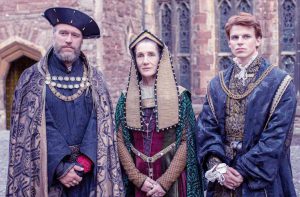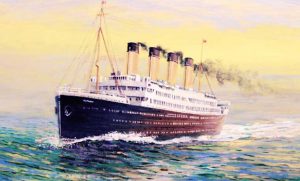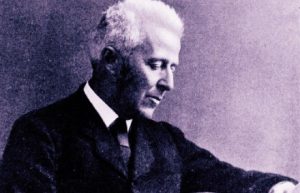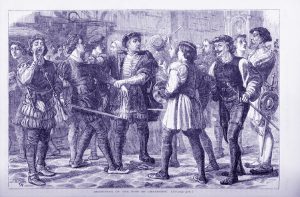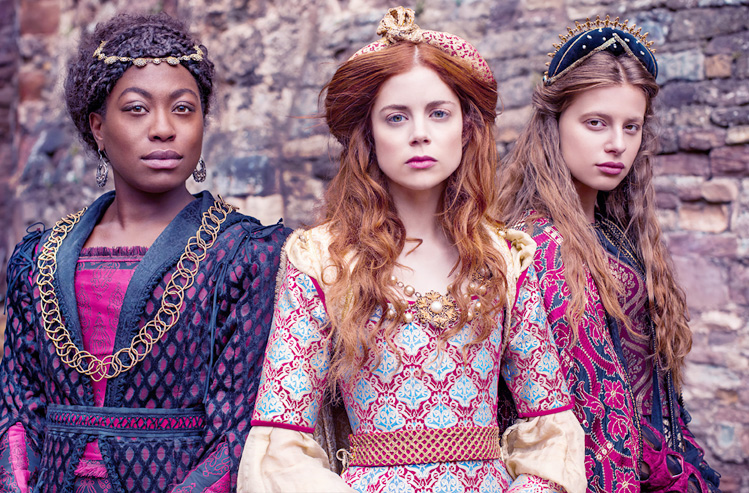
The Spanish Princess has captivated audiences with its lush costumes and dramatic portrayal of Catherine of Aragon’s early years, but how accurate is this Tudor-era television series when held up against the historical record? Based on Philippa Gregory’s novel, the show blends fact with fiction, often taking significant liberties with real events, characters, and timelines. In this essay, we’ll explore the historical inaccuracies in The Spanish Princess, separating the dramatized narrative from the documented truth about Catherine of Aragon, Henry VII, Elizabeth of York, Henry VIII, and the Tudor court.
With over 25 years of studying the Tudor period and a seven-book Tudor historical fiction series to my name, I bring a well-researched and passionate perspective to the lives of Henry VII, Catherine of Aragon, and the court that shaped them. If you enjoy peeling back the layers of fact and fiction in Tudor dramas, you’ll feel right at home here, and maybe even find yourself intrigued enough to explore my novels that bring this world to life in rich, imaginative detail.
My Love Affair with the Tudor Family
Before I dive into discussing the historical inaccuracies in this series, allow me to introduce myself and my history with being fanatical about the Tudors! (Warning: I have a bias in favor of Margaret Beaufort, Henry VII, Elizabeth of York, and Catherine of Aragon. I don’t dislike anyone in the Tudor period, but I hate to see historical figures slandered who cannot defend themselves. Inaccuracies that serve the plot are fine with me, but I hate writers placing modern ideals, morals, beliefs, or “hot takes” upon historical figures, accusing them of nefarious deeds, or ignoring the influence their religious convictions would have upon their life.)
I came to my fascination with Catherine of Aragon through Anne Boleyn. I developed a passion for her after seeing Anne of the Thousand Days, but after a single season of The Tudors, my allegiance swerved toward Catherine out of a deep and abiding respect for her dignity and religious convictions. I did a deep dive and became obsessed, writing my first novel about her in my twenties. It was an epic volume of 900 pages, in which I spanned everything from her childhood to her death. Then I put it on the shelf and went about writing other things and honing my skills.
Ten years ago, I took her down, dusted her off, and one historically accurate novel became a seven-part series of tightly plotted historical fiction, complete with author’s notes in the back owning up to what I added. Catherine (or Katharine, as I spell her in the pages of the book, because that’s how she wrote it) needed room to breathe, so I populated her world with rich characters from history and my imagination, a series of real figures (such as Henry VII and his wife and children, Sir Thomas Lovell, his royal enforcer, various dukes, duchesses, traitors, and Lambert Simnel, the Pretender) and with fictional characters, to enable me to craft suspense-driven plots in which you, the audience, don’t know what will happen outside of the historic events.
I became possessive of these people, whom I spent hours, weeks, days, months, and years studying, across a vast number of research books. I developed an admiration for Margaret Beaufort and her charitable works, a respect for Henry VII’s strategic thinking, a deep appreciation for the tragic Margaret Pole, a fondness for the loyal and brave Estrella de Salinas, and yes, esteem for Catherine.
So, their “slander” in this series bugs the 💩 out of me, and I am going to draw attention to it wherever I find it. If a bias in their favor (giving them the benefit of the doubt) offends you, click away. Or stay tuned for my entertaining take-down of every single episode of the television adaptation of a book that made me want to rip off my eyelids off and set fire to them. I settled for watching a friend torch her copy of The Constant Princess instead. Enjoy!
Episode One: The New World
Catherine of Aragon arrives in England to marry Prince Arthur, the heir to the Tudor throne. As she adjusts to life in a foreign court, political tensions and cultural clashes begin to surface, setting the stage for one of history’s most dramatic royal marriages.
Catalina and Oviedo: Based in Truth, Twisted by Fiction
Catalina is loosely based on a real woman while Oviedo was a Spanish archer (or a trumpeter, accounts disagree on his profession) who served in Catherine’s household. The historical record confirms they were married, but we know little else about them. The show merges Catalina’s character with the real-life Doña Elvira, Catherine’s overbearing duena and head of her household, who raised her from childhood, and it omits three of her most famous ladies-in-waiting: Francesca, Inez, and Maria Salinas (named Estrella in my novels). While Catalina is Black on the series, most Spanish Moors were Arab or Berber rather than sub-Saharan African. The term “Blackamoor” could refer to either group. Catherine did bring African servants to England, where they were seen as symbols of exotic wealth.
Margaret Beaufort: Political Ally, Not Petty Opponent
Depicting Margaret Beaufort as antagonistic toward Catherine is a distortion of the truth. A Spanish marriage legitimized her son’s claim to the throne and broadcasted to Europe that Spain saw Henry VII as a rightful monarch, not the usurper his enemies claimed him to be. He had rivals in the Netherlands trying to drum up military support to challenge his rule, and needed to secure his position. Margaret corresponded with Ferdinand and Isabella to secure the marital alliance. Spain required England’s support in its wars with France, and England needed Spanish protection against. Far from objecting to the union, Margaret helped broker it and retired from public court life shortly after the wedding. Her continued presence in the series (and her personal dislike of Catherine) has no historical basis.
Elizabeth of York: A Supportive Mother-in-Law, Not a Rival
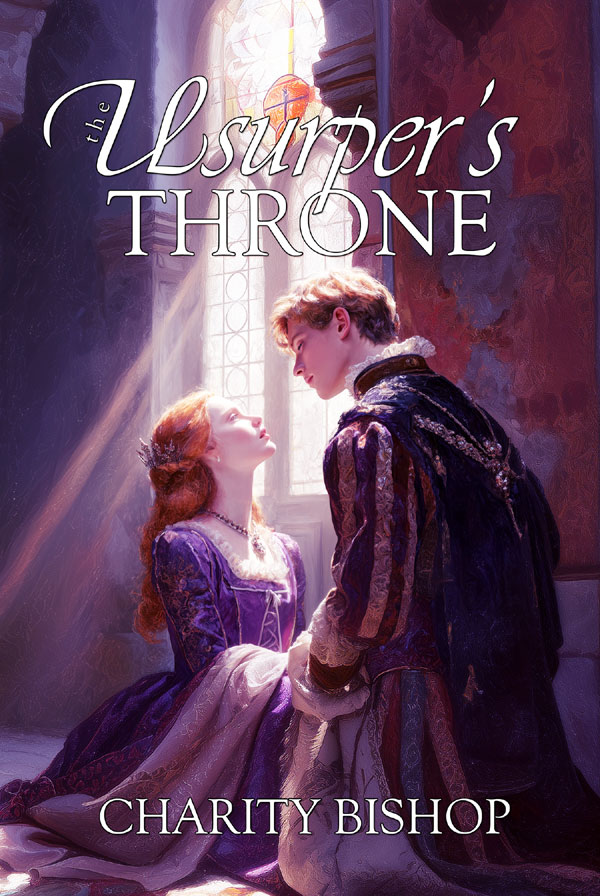
The show portrays Elizabeth of York as icy and confrontational toward Catherine, but sources suggest the opposite. Catherine arrived in England grieving her isolation and homesickness, and the gentle and kind Elizabeth provided her with comfort and maternal support. They reportedly had a warm relationship until the queen’s death in 1503 severed their bond. The infamous kiss-and-threat scene feels like a modern soap opera rather than a depiction of actual court life. Once again, the writers undermine all their female friendships in favor of rivalries and drama.
Henry VII: The Real Power Broker
Henry VII is portrayed here as a timid man overly reliant on the women around him, which downplays his political brilliance. Historically, Henry was shrewd, calculating, and highly capable. He stabilized England’s economy through clever taxation policies and maintained tight control over diplomatic arrangements, including the Spanish alliance. After Elizabeth of York’s death, he became reclusive, but never indecisive. The bearded depiction of Henry is also incorrect. Beards were out of fashion in Tudor England at the time, more common among Scots and Welshmen than English nobility.
Catherine of Aragon: A Young Diplomat in the Making
The Catherine shown in this episode is more like her older, future self, unyielding, proud, and passionate. While that part is accurate, it ignores her early diplomacy and tact. That said, her complaints about the cold are spot-on. Catherine struggled with England’s damp climate and frequently fell ill due to the chill.
Prince Henry (the Future Henry VIII): Ten, Not Seventeen
One of the show’s most glaring inaccuracies is the age of “Harry.” When Catherine arrived, he was only ten years old, not a teenage romantic fantasizing about his brother’s wife. In reality, Henry and Catherine barely interacted at this point. He was raised in a separate household, and their connection only developed years later, after Arthur’s death.
Isabella of Castile: Fair-Haired Queen of Spain
The show portrays Isabella as dark-haired and imperious, but portraits and accounts describe her as fair-haired, contrasting her with her darker husband, Ferdinand of Aragon. Their union joined two Spanish kingdoms with distinct regional traits, and their daughter Catherine inherited her looks from both, but took after her mother in her diminutive stature and reddish hair. The writers also misattribute the execution of Edward Plantagenet, Duke of Warwick, to Isabella. In reality, Ferdinand demanded Warwick’s death as a condition for the Spanish alliance. (Again, the series is trying to downplay the power of its men, in favor of highlighting controlling, dominating women who hate each other.)
Catherine’s Arrival: A Lost Opportunity for Grandeur
The series glosses over Catherine’s arrival in England, which was a spectacle of grand pageantry. From the moment she stepped ashore in Plymouth to her triumphant entry into London, her journey was filled with bonfires, pageants, and performances, a royal welcome fit for a future queen that cost Henry a small fortune. He considered it worth the investment. This cultural landmark moment deserves far more attention. (I explore it in depth in my novel The Usurper’s Throne.)
Sexual Morality: Misapplied Modern Commentary
In a baffling scene, Catalina lectures another lady-in-waiting about the dangers of sexual impropriety, as if Rosa wouldn’t know. Women in Isabella’s court were expected to be above reproach, in accordance with their Spanish Catholic faith. Isabella dismissed ladies who compromised themselves. Girls raised in that culture were fully aware that their virtue determined their marriage prospects, and their marriages would be arranged for political advantage. Serving in Catherine’s court offered a chance to marry well in England. Catherine or the Spanish ambassador would arrange matches as part of a lady’s service and dowry.
Final Thoughts
Some dramatic license is expected in historical fiction, but The Spanish Princess takes liberties that distort the characters and misrepresent political realities. While the show offers stunning visuals and an engaging story, it often sacrifices historical nuance for simplified plots and modern sensibilities. Still, it opens a door for deeper conversation and invites us to explore the true stories behind the drama. If you’d like to discover a historically grounded, richly imagined version of Catherine of Aragon and her world, take a look at The Usurper’s Throne, the first book in my Tudor Throne Series.

